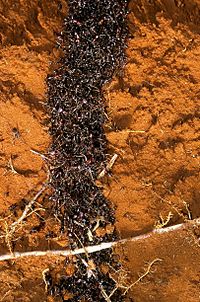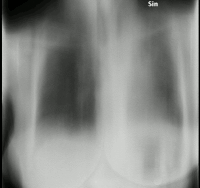
Cryptic species and parallel genetic structuring in Lethrinid fish: Implications for conservation and management in the southwest Indian Ocean
Sign Up to like & getrecommendations! Published in 2018 at "Ecology and Evolution"
DOI: 10.1002/ece3.3775
Abstract: Abstract Analysis of genetic variation can provide insights into ecological and evolutionary diversification which, for commercially harvested species, can also be relevant to the implementation of spatial management strategies and sustainability. In comparison with other… read more here.
Keywords: lethrinid fish; indian ocean; management; cryptic species ... See more keywords

Cuticular hydrocarbons as potential mediators of cryptic species divergence in a mutualistic ant association
Sign Up to like & getrecommendations! Published in 2019 at "Ecology and Evolution"
DOI: 10.1002/ece3.5464
Abstract: Abstract Upon advances in sequencing techniques, more and more morphologically identical organisms are identified as cryptic species. Often, mutualistic interactions are proposed as drivers of diversification. Species of the neotropical parabiotic ant association between Crematogaster… read more here.
Keywords: cryptic species; ant association; chc profiles; association ... See more keywords
Accurate population genetic measurements require cryptic species identification in corals
Sign Up to like & getrecommendations! Published in 2018 at "Coral Reefs"
DOI: 10.1007/s00338-018-1679-9
Abstract: Correct identification of closely related species is important for reliable measures of gene flow. Incorrectly lumping individuals of different species together has been shown to over- or underestimate population differentiation, but examples highlighting when these… read more here.
Keywords: species identification; cryptic species; population genetic; genetic species ... See more keywords

Haemoproteus syrnii (Haemosporida: Haemoproteidae) in owls from Brazil: morphological and molecular characterization, potential cryptic species, and exo-erythrocytic stages
Sign Up to like & getrecommendations! Published in 2020 at "Parasitology Research"
DOI: 10.1007/s00436-020-06958-z
Abstract: Haemoproteus syrnii is a haemosporidian parasite found in owls. Although morphological and molecular data on the species is available, its exo-erythrocytic development was never researched. In this study, we provide the morphological, morphometric, and molecular… read more here.
Keywords: haemoproteus syrnii; potential cryptic; molecular characterization; exo erythrocytic ... See more keywords

Larval size-distributions of Ariosoma balearicum cryptic species during the March–April season in the Sargasso Sea Subtropical Convergence Zone
Sign Up to like & getrecommendations! Published in 2019 at "Environmental Biology of Fishes"
DOI: 10.1007/s10641-019-00900-8
Abstract: Leptocephali of the shallow-water congrid eel Ariosoma balearicum are abundant during February–April in the Sargasso Sea, and larval and adult meristic data indicates this species includes several regional subpopulations/cryptic species. Four multiple-transect larval surveys (2011,… read more here.
Keywords: sea subtropical; ariosoma balearicum; size; cryptic species ... See more keywords
Reproductive isolation, morphological and ecological differentiation among cryptic species of Euchlanis dilatata, with the description of four new species
Sign Up to like & getrecommendations! Published in 2019 at "Hydrobiologia"
DOI: 10.1007/s10750-019-3892-0
Abstract: Morphological approaches may not provide sufficient resolution for species delineation. Thus, we used an integrated approach that included molecular and ecological characters as well as morphological features to gain a better estimate of species diversity… read more here.
Keywords: four new; reproductive isolation; cryptic species; among cryptic ... See more keywords

The importance of hidden diversity for insect conservation: a case study in hoverflies (the Merodon atratus complex, Syrphidae, Diptera)
Sign Up to like & getrecommendations! Published in 2018 at "Journal of Insect Conservation"
DOI: 10.1007/s10841-018-0111-7
Abstract: Cryptic species represent a large component of hidden biodiversity. Some cryptic taxa require specific climate and habitat conditions and have limited dispersal abilities. In order to assess the importance of cryptic species and to minimize… read more here.
Keywords: atratus complex; conservation; merodon atratus; cryptic species ... See more keywords

Courtship in Two Morphotypes of the Anastrepha fraterculus (Diptera: Tephritidae) Cryptic Species Complex and their Implications for Understanding Mate Recognition
Sign Up to like & getrecommendations! Published in 2018 at "Journal of Insect Behavior"
DOI: 10.1007/s10905-018-9697-6
Abstract: Ritualized courtship behaviors are used to recognize potential mates and behavioral patterns are inevitably different among populations that demonstrate reproductive incompatibility. We characterized and compared the courtship behaviors of two morphotypes of the cryptic species… read more here.
Keywords: courtship behaviors; anastrepha fraterculus; cryptic species; courtship ... See more keywords

Proven Invasive Pulmonary Aspergillosis in Stem Cell Transplant Recipient Due to Aspergillus sublatus, a Cryptic Species of A. nidulans
Sign Up to like & getrecommendations! Published in 2017 at "Mycopathologia"
DOI: 10.1007/s11046-017-0223-8
Abstract: Invasive fungal disease represents one of the severe complications in haematopoietic stem cell transplant recipients. We describe a case of a patient treated for relapse of chronic lymphoblastic leukaemia 6 years after HSCT. The patient was… read more here.
Keywords: pulmonary aspergillosis; stem cell; invasive pulmonary; cryptic species ... See more keywords

First description of a new cryptic species, Simulium vanluni from Peninsular Malaysia: An integrated morpho-taxonomical and genetic approach for naming cryptic species in the family Simuliidae.
Sign Up to like & getrecommendations! Published in 2017 at "Acta tropica"
DOI: 10.1016/j.actatropica.2016.12.009
Abstract: In recent decades, the numbers of cryptic taxa have increased significantly with current progress in DNA barcoding, yet, most of these cryptic taxa have not been formally named and recognized as valid species. To address… read more here.
Keywords: species family; peninsular malaysia; cryptic species; simulium vanluni ... See more keywords

Phylogenetic analysis reveals cryptic species diversity within minute intestinal fluke, Stellantchasmus falcatus Onji and Nishio, 1916 (Trematoda, Heterophyidae).
Sign Up to like & getrecommendations! Published in 2017 at "Asian Pacific journal of tropical medicine"
DOI: 10.1016/j.apjtm.2017.01.016
Abstract: OBJECTIVE To examine the taxonomic boundaries in the Stellantchasmus populations in different hosts and reveal the cryptic speciation of the Stellantchasmus in Thailand based on both morphological and molecular approaches. METHODS Stellantchasmus falcatus (S. falcatus) s.l.… read more here.
Keywords: diversity; stellantchasmus falcatus; cryptic species; different hosts ... See more keywords